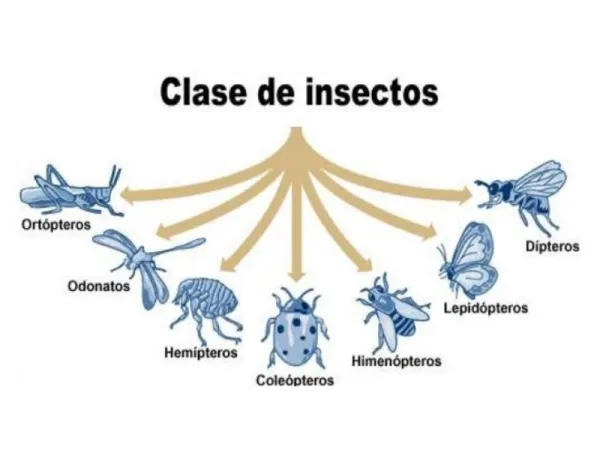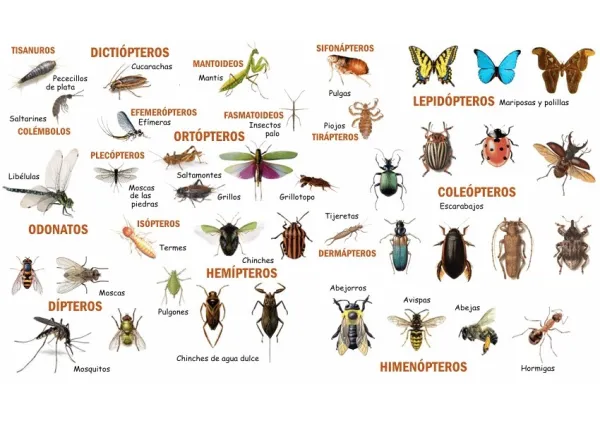Insects are the most species-rich animals on Earth, occupying nearly every terrestrial and freshwater habitat—from deserts and mountaintops to tropical rainforests. Knowing how entomologists organize insect diversity, how to read their external anatomy, and how they feed and reproduce will help you understand the roles insects play in food webs (pollination, decomposition, biocontrol, and more).

Below are field-friendly IDs: Chinese/English name → Latin name → key traits → typical examples.
Odonata
Key traits: Slender body, huge compound eyes, short antennae; strong, toothed mouthparts; two pairs of membranous wings with dense venation; aquatic, predatory nymphs.
Examples: Dragonflies and damselflies (damselflies are slimmer and often fold wings over the back at rest).
Blattodea
Key traits: Front wings leathery or half-leathery; long, threadlike antennae; chewing mouthparts; mostly nocturnal, omnivorous or detritivorous.
Examples: Cockroaches.
Orthoptera
Key traits: Powerfully built hind legs for jumping; narrow, tougher forewings and broad fanlike hindwings; many males “stridulate” (rub structures to make sound).
Examples: Grasshoppers/locusts, crickets.
Phthiraptera
Key traits: Wingless, small ectoparasites of birds and mammals; mouthparts adapted for piercing/sucking or chewing host tissues.
Examples: Human head louse, livestock lice.
Coleoptera
Key traits: First wing pair hardened into protective elytra covering the membranous hindwings; astonishing ecological range.
Examples: Scarab beetles, ground beetles, lady beetles/ladybirds.
Diptera
Key traits: Adults with one pair of wings; the hindwings reduced to halteres (balancing organs); mouthparts for piercing/sucking or sponging; larvae often called maggots.
Examples: Houseflies, fruit flies, mosquitoes.
Lepidoptera
Key traits: Two pairs of wings clothed in scales; adults with a coiled proboscis for nectar; larvae are caterpillars.
Examples: Butterflies and moths.

Insects are encased in a cuticular exoskeleton (chitin-rich), which protects, prevents water loss, and anchors muscles. Growth requires molting (shedding the old cuticle).
Head: A rigid head capsule bearing compound eyes (often with ocelli), one pair of antennae (chemo/ mechanosensation), and mouthparts (chewing, piercing-sucking, siphoning, or sponging depending on order).
Thorax: Three segments—pro-, meso-, meta-thorax—each typically with a pair of legs (total three pairs = six legs). Wings, if present, arise from the meso- and metathorax (two pairs in most winged orders; modified in Diptera and Coleoptera).
Abdomen: Usually 7–11 segments. Distal segments house the genitalia and various appendages (e.g., ovipositor, claspers). Gas exchange commonly uses spiracles opening to a tracheal system.

Herbivores: Leaf, stem, root, seed, or fruit feeders; aquatic and terrestrial forms.
Predators/parasitoids/parasites: From mantises and ground beetles to parasitoid wasps/flies; lice and fleas are external blood-feeders.
Nectar & pollen feeders (pollinators): Butterflies, bees, hoverflies, etc., driving plant pollination.
Detritivores/decomposers: Dung beetles, carrion beetles, and many fly larvae cycle nutrients.
Holometaboly (complete metamorphosis): Egg → larva → pupa → adult. Larvae often occupy different habitats/diets from adults.
Orders: Lepidoptera, Coleoptera, Diptera, Hymenoptera (bees/ants/wasps), etc.
Hemimetaboly (incomplete metamorphosis): Egg → nymph/naiad → adult, no pupal stage; juveniles resemble miniature adults and gradually acquire wings.
Orders: Odonata, Orthoptera, many Hemipterans, etc.
Sexual reproduction is most common (mating, egg-laying, variable incubation).
Parthenogenesis: Development from unfertilized eggs.
Polyembryony: A single fertilized egg splits into multiple embryos (notably in some parasitoid wasps).
Viviparity/ovoviviparity: Embryos develop largely within the female; young are born live or as near-hatching eggs.
Modern systematics separates some wingless six-legged lineages from true insects; they’re often grouped in Hexapoda for convenience. Below matches common, broad usage:
Silverfish (Lepisma saccharina) — a wingless, primitive insect; nocturnal, moisture-loving.
Human head louse (Pediculus humanus capitis) & cattle long-nosed louse (Haematopinus eurysternus) — wingless insects, ectoparasitic blood feeders.
Fleas (Family Pulicidae) — wingless insects with enlarged hind legs for jumping; adult blood feeders.
Campodea maestrazgoensis — Diplura (two-pronged bristletails), a non-insect hexapod, cave-dwelling, moisture-dependent.
Anurida maritima & Papirius saundersi — Collembola (springtails), non-insect hexapods common in soil, litter, and even tidepools.
Body plan: Head–thorax–abdomen, 3 pairs of legs, usually 2 pairs of wings (order-specific modifications or losses).
Respiration: Spiracles → tracheae (some cutaneous or specialized exchanges).
Mouthparts: Chewing (beetles), piercing–sucking (lice, bugs, mosquitoes), siphoning (butterflies/moths), sponging (many flies).
Ecosystem services: Pollination, nutrient recycling, pest suppression; some species are pests or disease vectors and require science-based management.
Insect diversity isn’t just a numbers game—it’s also about morphology, behavior, and life cycles. If you can recognize the major orders, read the head–thorax–abdomen blueprint, and understand metamorphosis, you’ll be well equipped to identify common groups and explain their ecological roles on any wildlife page.
animal tags: insect classification
We created this article in conjunction with AI technology, then made sure it was fact-checked and edited by a Animals Top editor.